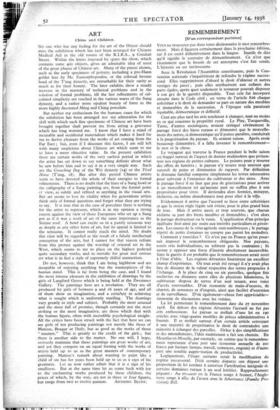ART
China and Children.
No one who has any feeling for the art of the Orient should miss the exhibition which has just been arranged for Chinese Medical Aid in the old rooms of the R.I.B.A., 9 Conduit Street. Within the limits imposed by space the show, which contains some 400 objects, gives an admirable idea of most of the great phases of Chinese art. Many of the pieces shown, such as the early specimens of pottery, including a pre-Hann goblet lent by Mr. Eumorphopoulos, or the colossal bronze head of the T'ang dynasty, are remarkable for their rarity as much as for their beauty. The later exhibits show a steady increase in the mastery of technical problems and in the solution of formal problems, till the last refinements of cal- culated simplicity are reached in the various wares of the Sung dynasty, and a rather more opulent beauty of form in the more highly decorated Ming and Ching porcelain.
But neither my enthusiasm for the humane cause for which the exhibition has been arranged nor my admiration for the skill with which such fine specimens of Chinese art have been brought together shall prevent me from airing a grievance which has long worried me. I know that I have a mind of incurable and occidental materialism which makes it hard for me to derive pleasure from the works of art coming from the Far East ; but, even if I discount this factor, I am still left with many suspicions about Chinese art which seem to me to have a more objective value. In the present exhibition there are certain works of the very earliest period in which the artist has sat down to say something definite about what he saw before him and to say it in a very simple way. Such are the Crouching Dog of the Wei dynasty (14) or the Tired Horse (T'ang, 18). But after this period Chinese artists seem to have devoted the whole of their energies to formal refinements. There is no doubt that the lines of a Sung bowl or the calligraphy of a Sung painting are, from the formal point of view, as subtle and refined as anything in the visual arts. But art seems to lose its vitality when for generations artists think only of formal questions and forget what they are trying to say. It is true that in the case of porcelain there is nothing for the artist to represent, which is in my opinion a strong reason against the view of those Europeans who set up a Sung pot as if it was a work of art of the same importance as the Sistine roof. A bowl can excite us in a purely sensuous way as deeply as any other form of art, but its appeal is limited to the sensuous. It cannot really reach the mind. No doubt this view-will be regarded as the result of a falsely intellectual conception of the arts, but .I cannot for that reason refrain from this protest against the worship of oriental art in the West, which seems to me to place on the highest pedestal quite secondary works, and to mistake for great and serious art what is in fact a style of supremely skilful mannerism.
Do not, however, think that I am being highbrow and am incapable of enjoying anything but the masterpieces of the human mind. This is far from being the case, and I found the most intense pleasure in the exhibition of drawings by the girls of Langford Grove which is being held at the Zwemmer Gallery. The paintings here are a revelation. They are all produced by girls of between 9 and i6 years of age, and all of them show an imagination, and a certa\ty in achieving what is sought which is uniformly startling. The drawings vary greatly in style and subject. Probably the most unusual and the most full of promise, though certainly not the most striking or the most imaginative, are those which deal with the human figure, often with incredible psychological insight. All the critics have been struck with the fact that here we can see girls of ten producing paintings not merely like those of Matisse, Braque or Dufy, but as good as the works of those " masters." This is greatly to the credit of the girls ; but . there is another side to the matter. No one will, I hope, seriously maintain that these paintings are great works of art, and yet they compete on an equal footing with the works of artists held up to us as the great masters of contemporary painting. Matisse's remark about wanting to paint like a child of six has for years been held up to us as a sign of his greatness. Let us now rather admit that it is a sign of his smallness. But at the same time let us come back with joy to the enchanting works produced by these children, the prices of which, by the way, are not in three or four figures, but range from two to twelve guineas. ANTHONY BLUNT.






































 Previous page
Previous page